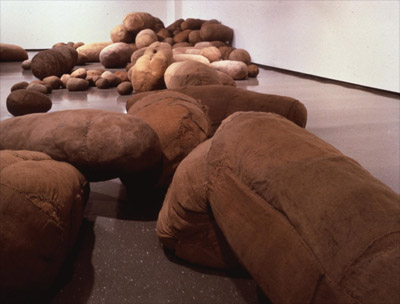
| HOME |
| NERVE |
| REVIEWS |
| ARCHIVE |
| EVENTS |
| LINKS |
| ABOUT US |
| CONTRIBUTORS |
| BACK ISSUES |
| CONTACT US |
 Touched
Touched
Tate Gallery, Albert Dock
18th September – 28th November 2010
Reviewed by Sandra Gibson
This exhibition offers a varied, multimedia experience through art from several cultures. It’s a challenge on several levels.
“Who can afford the time, attention, energy to be touched? To be touched it is necessary to be bold, to be vulnerable.” (Lewis Biggs, Artistic Director, Liverpool Biennial.)
Some works of art are so tactile you have a job not to rub your fingers into them: Chaim Soutine, Anselm Keifer, Willem de Kooning… but the convention is to touch with the eyes only. Otto Muehl’s paintings in this exhibition look as if the paint is still malleable and their thick textured quality makes the technique arguably more significant than the subject matter.
The exhibition at the Tate is tantalising in that way. Magdalena Abakanowicz’s installation Embryology (above) just invites interference! Large bulky packages of earthy stuff tempt you to touch and rummage and lounge amongst them. But you mustn’t. The child in you who made mud pies and sand castles and sifted pebbles wants to but you mustn’t.
OK, you shrug, what’s next?
Jamie Isenstein’s installation with lights is imbued with a peacefulness that is challenged by something rather macabre: there is a realistic hand at the end of a “fire-hose” which turns out to be a real hand. That’s not the macabre thing, though. The artist, whose hand it is, and who can hear all the reactions, originally gave permission for people to touch. But this had to be withdrawn because some people abused the opportunity. It’s still interesting to experience the desire to hold the hand and what a shock it must have been for those who presumed the hand was a facsimile. A note-worthy interaction even without the touching.
What else? Nina Canell’s work with invisible energies is elegant and visual as well as conceptual. I particularly appreciated the sense of aftermath and potential in the grinding stone and its residual seeds: the absence of sound and energy balanced by the concentrated energy in the seeds. The presentation of the first and last page of Holst’s Neptune invites a varied response. The musical hieroglyphs have a shape and energy of their own irrespective of their representational role as the visual equivalent of potential sound. And what of the absence of the rest of the musical notation? In another exhibit, water from varying depths of the Mersey is displayed in parallel containers - when it would normally have been contiguous - and in turn becomes the medium for changing light levels. It will itself change as the result of this exposure. The ideas awoken by these installations resonate beyond the moment of perception.
The surrealistic work of Diango Hernandez addresses the notion of deconstruction and witty reconstruction. Is this a Victorian tiled floor or the structure of something microscopic? Where does this stairway of chair-backs lead? Alfredo and Isabel Aquilizan’s schools project also produces a sense of the surreal. Nautical shapes in cardboard are attached to cardboard boxes. There are exhausting amounts of brown sticky tape and you can mentally hear the tearing sounds of young endeavour, and there is a feeling of immensity all unified by a creaking boardwalk and made mysterious by dim lighting which creates shadows. And through the windows, rendered small by distance are the real vessels which inspired this installation.
Eva Kotatkova also looks at scale and relates it to childhood and memory, incorporating video and audio components and producing an interactive experience. It’s tempting to rearrange the miniature furniture.
Wannes Goetschalckx, on the other hand, emphasises the closed-off nature of human experience. A series of video screens show the artist engaged in various solitary activities: eating, drinking, underwater, counting, on a swing, crouching, shelling peas, defaecating and masturbating. A Northern comedian said that every morning when he woke up he pushed out his elbows and if they did not touch wood he knew he was still alive. Goetschalckx’s claustrophobic enclosure of wooden boxes reminds me of this moment of comedic black humour and it’s a good place for the exhibition to end.